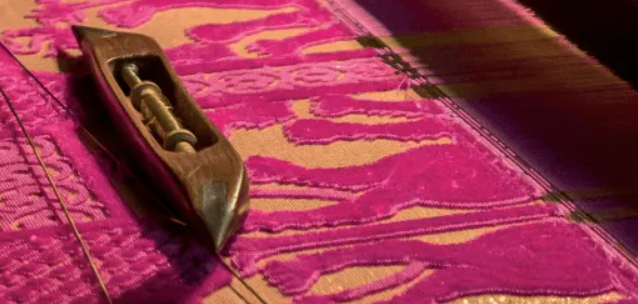
Timeless Fabrics of Venice: Bevilacqua, Rubelli & Fortuny
Venice is famous for its canals, historic palaces, and unmistakable charm. But there’s another, lesser-known treasure waiting to be discovered: the art of textile weaving. Just stroll through the narrow streets or step inside a centuries-old palace, and you’ll find yourself surrounded by rich velvets, damasks, and brocades: each one telling a story of elegance and tradition.
Among the most iconic names keeping this heritage alive are Tessitura Luigi Bevilacqua, Rubelli, and Fortuny.
Tessitura Luigi Bevilacqua: Handcrafted Velvet at Its Finest
Founded in the 1600s and still operating with 18th-century looms, Tessitura Bevilacqua is one of the last places in the world where soprarizzo velvet is entirely woven by hand. Each centimeter of fabric requires hours of meticulous, almost meditative work.
Tucked away in the Santa Croce district, this workshop is a hidden gem where every thread is steeped in history and craftsmanship. Bevilacqua fabrics have dressed popes, emperors, opera houses, and noble residences around the globe. Today, they’re sought after by haute couture fashion houses and collectors alike.
Visiting the workshop (by appointment) feels like stepping back in time. Each loom whispers centuries of Venetian history, and every fabric is a unique masterpiece.
Rubelli: Innovation Meets Tradition
Founded in 1858, Rubelli represents the modern soul of Venetian textiles: always looking ahead, without losing sight of the past. Based in the stunning Palazzo Corner Spinelli on the Grand Canal, the brand is known worldwide for its innovation, design, and textile research.
Rubelli reimagines the classical motifs of the Serenissima with a contemporary twist, collaborating with internationally renowned architects and designers. Its fabrics decorate museums, luxury hotels, and elegant homes across the world, and are often used in historically accurate restorations.
One of Rubelli’s greatest strengths lies in its balance between craftsmanship and technology. Alongside its state-of-the-art production site near Lake Como, Rubelli maintains a Venetian workshop featuring historic looms still in use, thereby preserving the soul of traditional weaving.
Fortuny: Where Art, Light, and Timeless Fabrics Come Together
In the heart of the Giudecca island, inside a former factory turned creative lab, the legacy of Mariano Fortuny lives on. Artist, inventor, and visionary, Fortuny founded his namesake textile house in the early 1900s. Today, Fortuny Venezia is much more than a textile workshop: it’s a place where art meets innovation, and fabrics tell stories of light, color, and experimentation.
Every collection is handcrafted and exported worldwide, featured in exclusive interior design projects, theaters, and luxurious residences. Visiting the Fortuny workshop is a truly immersive experience, where each fabric is the result of a mysterious and refined artistic process.
In Campo San Beneto, Palazzo Fortuny is home to the Fortuny Museum, where two entire floors display Mariano Fortuny’s masterpieces, keeping his creative vision alive. This immersive, themed exhibition features over 90% of the original Fortuny-related material owned by Venice’s civic museums, now beautifully on display for the public.
Staying in Venice means stepping into a world where textiles are not just décor: they’re a form of identity.
For those curious to explore this refined world up close, many of these ateliers offer guided tours by appointment. Or, you can simply wander into their boutiques and showrooms to admire the artistry and maybe even take a piece of Venetian heritage home with you.
